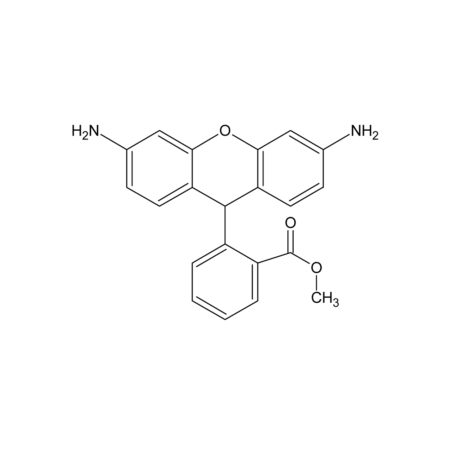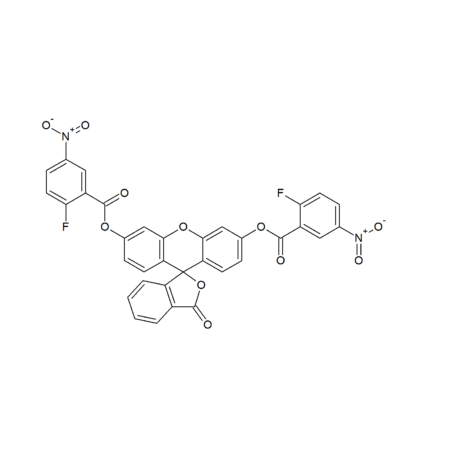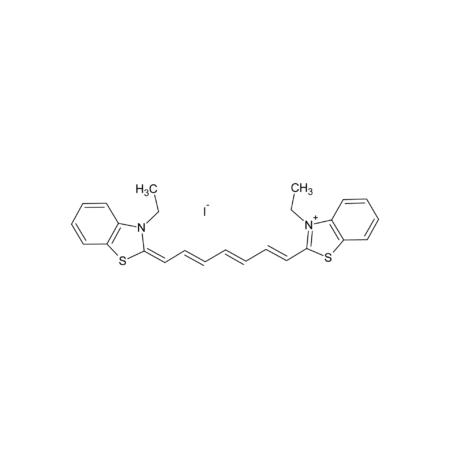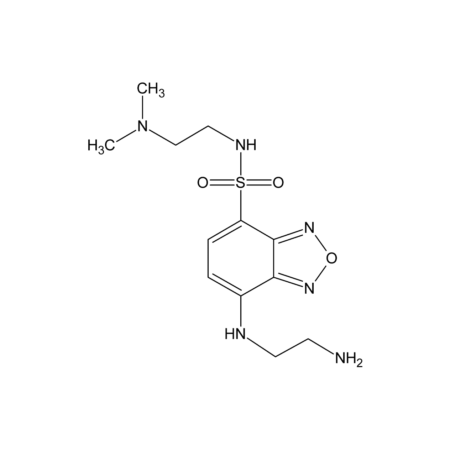Dihydrorhodamine 123
- SKU
- D0134
Category: Fluorescent Detection, Fluorescent Detection
- Synonyms
- DHR
- 109244-58-8
- CAS-Number
- C21H18N2O3
- Molecular Formula
- 346.38
- Molecular Weight
Specifications
- Purity
- ≥95% (NMR)
- Appearance
- Pink solid
- Identity
- 1H-NMR
Properties
- Solvents
- DMSO (5 mg/ml), DMF, chloroform, ethanol
- Fluorescence
- λex 500 nm, λem 525 nm in 0.1 M Tris pH 8.0 (after oxidizing with H2O2, peroxidase)
Downloads
- Safety Data Sheet
- CDX D0134 MSDS.pdf
- Shipping
- AMBIENT
- Short Term Storage
- +4°C
- Long Term Storage
- -20°C
- Handling Advice
- Protect from light and moisture.
- Use / Stability
- Stable for at least 2 years after receipt when stored at -20°C.
- Transportation
- Not dangerous goods
- Description
- Cell-permeable non-fluorescent reactive oxygen species (ROS) indicator. Passively diffuse across membranes where it is oxidized by peroxynitrite to rhodamine 123 which localizes in the mitochondria and exhibits green fluorescence (Ex/Em wavelengths of 500 and 536 nm). Used to investigate reactive oxygen intermediates produced by human and murine phagocytes, activated rat mast cells and cultured endothelial cells. In addition, it has been used together with Fura Red calcium indicator to simultaneously measure oxidative bursts and Ca2+ fluxes in monocytes and granulocytes. Dihydrorhodamine 123 has been shown to be a more sensitive probe than H2DCFDA for detecting granulocyte respiratory bursts.
- Smiles
- COC(=O)C1=CC=CC=C1C1C2=CC=C(N)C=C2OC2=C1C=CC(N)=C2
- InChi Key
- FNEZBBILNYNQGC-UHFFFAOYSA-N
- References
- (1) K. Hensley et al.: Meth. Biol. Oxidative Stress 169 (2003) , (2) H. Ischiropoulos et al.: Meth. Enzymology 301, 367 (1999) , (3) L.M. Henderson et al.: Europ. J. Biochem. FEBS 217(3), 973 (1993)
- InChi
- InChI=1S/C21H18N2O3/c1-25-21(24)15-5-3-2-4-14(15)20-16-8-6-12(22)10-18(16)26-19-11-13(23)7-9-17(19)20/h2-11,20H,22-23H2,1H3
Cell-permeable non-fluorescent reactive oxygen species (ROS) indicator. Passively diffuse across membranes where it is oxidized by peroxynitrite to rhodamine 123 which localizes in the mitochondria and exhibits green fluorescence (Ex/Em wavelengths of 500 and 536 nm). Used to investigate reactive oxygen intermediates produced by human and murine phagocytes, activated rat mast cells and cultured endothelial cells. In addition, it has been used together with Fura Red calcium indicator to simultaneously measure oxidative bursts and Ca2+ fluxes in monocytes and granulocytes. Dihydrorhodamine 123 has been shown to be a more sensitive probe than H2DCFDA for detecting granulocyte respiratory bursts.





![7-Diethylamino-3-[N-(4-maleimidopropyl)carbamoyl]coumarin](https://www.chemodex.com/wp-content/uploads/2019/04/CDX-D0199-1-450x450.png)

